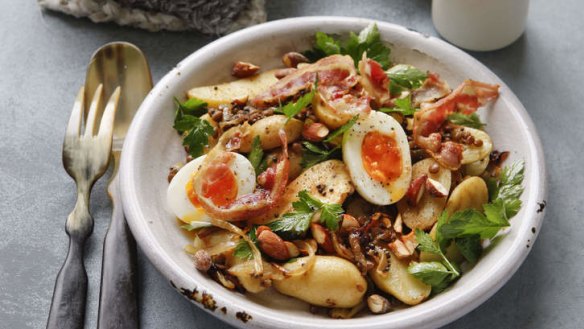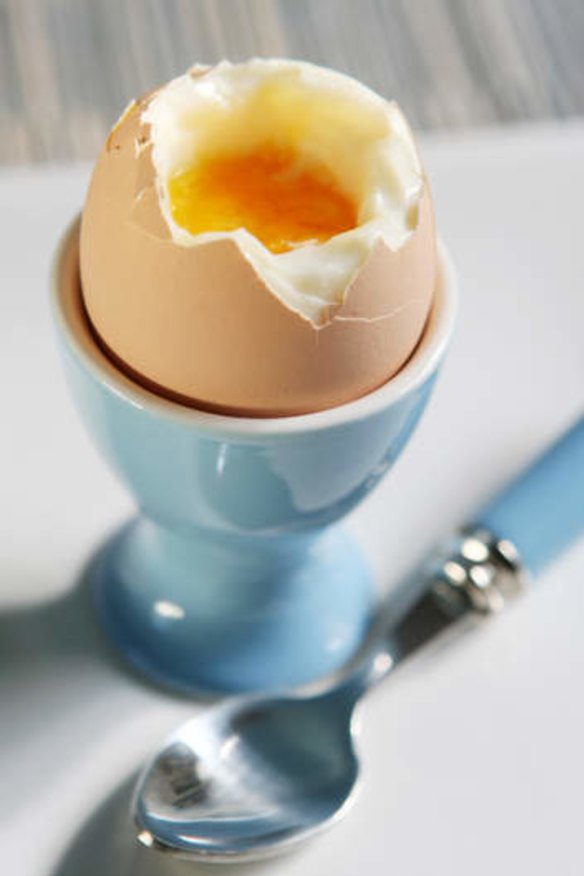How long does it take to boil an egg?

How long does it take to boil an egg? J. Hosking
Last year when I was in Spain working on a cookbook, I took photos of some dishes that were topped with hard-boiled eggs. When I looked back at the images I saw an ugly grey ring around the yolks. In Europe they have some nasty strains of salmonella and chefs are no longer allowed to make raw egg dishes and overcook their eggs just to be safe. How long to cook an egg will depend on the temperature of the eggs and water as well as the size of the egg and the volume of water. The bigger the egg, the longer it takes. The very runny and rather delicious oeuf a la coque, in which the white is creamy and the yolk are just warm (just right for dunking toast soldiers), takes three minutes when a 60-gram egg is plunged into two litres of boiling water. Boil for two minutes longer and you have a coddled egg. Boil for another minute and refresh in cold water and you have mollet eggs. This is an egg with a creamy soft yolk but the white set enough so the egg can be peeled and the yolk won't run – perfect to top salad with anchovies. Boil for 10 minutes in total and refresh in cold water and the egg will be hard-boiled but the yolk creamy, not crumbly.
Why doesn't stevia melt like sugar?

Sugar crystals are a bit like outspoken and outrageous regional politicians. Apply a bit of heat and they quickly fall apart. White sugar is sucrose, a disaccharide made up of carbon, hydrogen and oxygen atoms arranged to form two simple joined sugars, glucose and fructose. When you apply heat to sugar the energy in the heat causes the bonds that hold the crystalline structure to change and the molecule is rearranged, turning it from a crystalline structure to a liquid form. This happens at between 125C to 160C, depending on how long the sugar is heated. Stevia, on the other hand, is a leaf extract made up mostly of glycosides and does not fall apart when subjected to heat. Stevia is heat-stable to 200C. Interestingly the glucose in the glycosides, the bit that excites the sweet tastebuds, is not metabolised by the body, but is instead consumed by gut flora.
I tried a dish of fried elderflowers in Germany and want a good recipe. V. Sing
The Germans have a great dish of elderflower fritters or holderkuechle with fresh berries and soft milk curd. You'll find elderflowers growing on country roadsides around this time of year. Look for nice tight blooms that haven't completely unfurled their petals. Sophie Zalokar has a recipe in her new book Food of the Southern Forests (University of Western Australia Publishing, $59.99) in which a batter is made with 200 grams plain flour, 300 millilitres sparkling water, a small egg and a shot of grappa. This is mixed and left to stand. The elderflowers are dipped in it, fried and served with labna and mulled blueberries. Delicious.
How do I avoid a soggy bottom with my apple pies? J. Eyre
That sounds so Julian Cleary. Thank you. My mate, Melbourne baker Phillippa Grogan (full disclosure: I wrote a book with her) says the secret to a crisp pie crust is to make sure the oven is really well heated before getting the pie in the oven to start cooking the pastry. If your oven doesn't hold heat well try preheating it 20 degrees hotter than the suggested baking temperature, then turning the oven down when the pie goes in. She also recommends using intense flavoured, medium-sized cooking apples and putting the raw apple pieces into the pie shell with a scant amount of sugar. Larger apples with less flavour could have a high water to pulp ratio, causing excess water to leak out during cooking to soften your bottom.
If you have a vexing query email brainfood@richardcornish.com.au
Twitter: @Foodcornish
Appears in these collections
The best recipes from Australia's leading chefs straight to your inbox.
Sign upFrom our partners
Original URL: https://www.brisbanetimes.com.au/goodfood/recipes/how-long-does-it-take-to-boil-an-egg-20141029-11d07b.html
